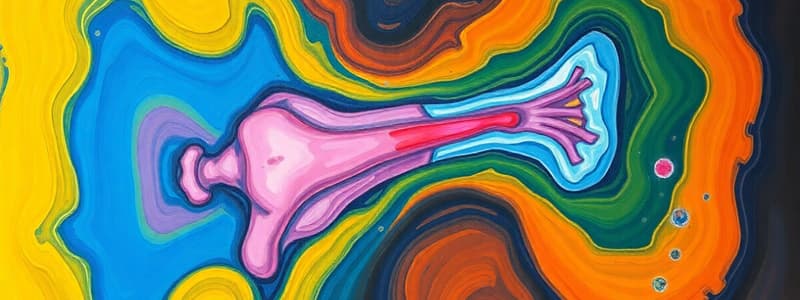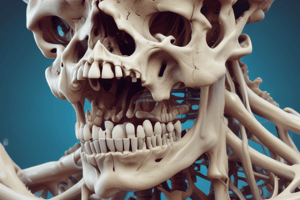Podcast
Questions and Answers
What anchors the epiphyseal plate to bone?
What anchors the epiphyseal plate to bone?
- Resting cartilage (correct)
- Calcified cartilage
- Proliferating cartilage
- Hypertrophic cartilage
Exercise does not affect bone remodeling.
Exercise does not affect bone remodeling.
False (B)
What marking indicates the closure of the epiphyseal plate?
What marking indicates the closure of the epiphyseal plate?
epiphyseal line
The zone of hypertrophic cartilage contains _____ cells arranged in columns.
The zone of hypertrophic cartilage contains _____ cells arranged in columns.
Match the following types of fractures with their characteristics:
Match the following types of fractures with their characteristics:
Which hormone inhibits or slows bone resorption by promoting apoptosis of osteoclasts?
Which hormone inhibits or slows bone resorption by promoting apoptosis of osteoclasts?
Bone remodeling occurs during growth and after injury.
Bone remodeling occurs during growth and after injury.
What is the process called that involves the destruction of the extracellular matrix in bone?
What is the process called that involves the destruction of the extracellular matrix in bone?
After a fracture, a ________ structure forms to stop bleeding.
After a fracture, a ________ structure forms to stop bleeding.
Which of the following is a factor affecting bone growth?
Which of the following is a factor affecting bone growth?
What is the first step in intramembranous ossification?
What is the first step in intramembranous ossification?
Endochondral ossification primarily forms flat bones.
Endochondral ossification primarily forms flat bones.
What type of cartilage do chondroblasts secrete during endochondral ossification?
What type of cartilage do chondroblasts secrete during endochondral ossification?
During intramembranous ossification, osteoblasts secrete the ECM of _____ tissue.
During intramembranous ossification, osteoblasts secrete the ECM of _____ tissue.
Match the type of ossification with the appropriate characteristics:
Match the type of ossification with the appropriate characteristics:
Which of the following bones is primarily formed through endochondral ossification?
Which of the following bones is primarily formed through endochondral ossification?
The periosteum is formed from mesenchymal tissue surrounding forming trabeculae.
The periosteum is formed from mesenchymal tissue surrounding forming trabeculae.
At what point does the secondary ossification center form?
At what point does the secondary ossification center form?
The zone of _____ cartilage is where bones grow lengthwise at the epiphyseal plate.
The zone of _____ cartilage is where bones grow lengthwise at the epiphyseal plate.
Which type of cartilage remains at the joints after endochondral ossification?
Which type of cartilage remains at the joints after endochondral ossification?
Flashcards
Intramembranous Ossification
Intramembranous Ossification
Bone formation starting from mesenchymal cells becoming osteoblasts, forming flat bones.
Osteoblasts
Osteoblasts
Bone-forming cells that secrete extracellular matrix and create new bone.
Trabeculae
Trabeculae
Structural network of spongy bone tissue formed during ossification.
Endochondral Ossification
Endochondral Ossification
Signup and view all the flashcards
Chondroblasts
Chondroblasts
Signup and view all the flashcards
Primary Ossification Center
Primary Ossification Center
Signup and view all the flashcards
Epiphyseal Plate
Epiphyseal Plate
Signup and view all the flashcards
Resting Cartilage Zone
Resting Cartilage Zone
Signup and view all the flashcards
Proliferating Cartilage Zone
Proliferating Cartilage Zone
Signup and view all the flashcards
Hypertrophic Cartilage Zone
Hypertrophic Cartilage Zone
Signup and view all the flashcards
Calcified Cartilage Zone
Calcified Cartilage Zone
Signup and view all the flashcards
Appositional Growth
Appositional Growth
Signup and view all the flashcards
Bone Remodeling
Bone Remodeling
Signup and view all the flashcards
Calcium Homeostasis
Calcium Homeostasis
Signup and view all the flashcards
Fracture Types
Fracture Types
Signup and view all the flashcards
Phases of Bone Repair
Phases of Bone Repair
Signup and view all the flashcards
Osteoporosis
Osteoporosis
Signup and view all the flashcards
Vitamin D Deficiency
Vitamin D Deficiency
Signup and view all the flashcards
Mechanical Stress
Mechanical Stress
Signup and view all the flashcards
Hormonal Influence on Bone Growth
Hormonal Influence on Bone Growth
Signup and view all the flashcards
Study Notes
Intramembranous Ossification
- Forms flat cranial and facial bones.
- Begins with mesenchymal cells differentiating into osteoblasts.
- Osteoblasts secrete extracellular matrix (ECM) forming an ossification center.
- Mineral salts deposited by osteoblasts calcify the ECM.
- Trabeculae form, creating spongy bone tissue.
- Connective tissue between trabeculae becomes red bone marrow.
- Mesenchymal tissue surrounding trabeculae compacts, forming the periosteum.
Endochondral Ossification
- Forms most bones, including long bones.
- Begins with mesenchymal cells differentiating into chondroblasts.
- Chondroblasts secrete collagen forming hyaline cartilage.
- Chondroblasts continue to secrete ECM, causing interstitial growth (length) and appositional growth (circumference).
- Nutrient artery penetrates the perichondrium.
- Osteoprogenitor cells become osteoblasts, forming trabeculae in the diaphysis (primary ossification center).
- Perichondrium compacts into the periosteum.
- Hyaline cartilage loses nutrients and degenerates.
- Primary ossification extends toward the ends of bones.
- Osteoclasts digest spongy bone, creating the medullary cavity.
- Secondary ossification centers form at birth creating epiphyses.
- Hyaline cartilage at joints becomes articular cartilage.
- Cartilage at metaphyses remains until adolescence.
Bone Growth
- Bones grow interstitially (lengthwise) and appositionally (circumferentially).
- Interstitial growth occurs at the epiphyseal plate.
- Epiphyseal plate has four zones: resting, proliferating, hypertrophic, and calcified.
Zones of the Epiphyseal Plate
- Zone of resting cartilage: Anchors the epiphyseal plate to bone.
- Zone of proliferating cartilage: Cells actively divide, contributing to interstitial growth.
- Zone of hypertrophic cartilage: Mature chondrocytes are large and arranged in columns.
- Zone of calcified cartilage: Contains layers of dead chondrocytes.
- Once the epiphyseal plate closes, chondrocytes stop dividing and ECM calcifies.
Appositional Growth
- Circumferential growth.
- Periosteal cells become osteoblasts.
- ECM ridges form around periosteal vessels, and fuse.
- Former periosteum becomes the endosteum.
- Endosteal osteoblasts secrete ECM, forming new concentric lamellae.
- Osteoclasts in the endosteum resorb bone, allowing the medullary cavity to grow.
Factors Affecting Bone Growth
- Nutrition: Adequate calcium, vitamin D, and other nutrients are crucial for bone growth.
- Hormones:
- Growth hormones stimulate osteoblasts during childhood and adolescence.
- Thyroid hormones (T3 and T4) stimulate osteoblasts.
- Estrogen inhibits bone resorption.
- Testosterone alters bone growth rates.
- Exercise: Weight-bearing exercise promotes bone remodeling and strength.
Bone Remodeling
- A dynamic, lifelong process.
- 5% of bone remodeled at any given time.
- Involves bone resorption (breakdown) and bone deposition (building).
- Occurs during growth, injury, and with changes in exercise and diet.
- Osteoclasts resorb bone, releasing minerals into the blood.
- Osteoblasts deposit bone along lines of mechanical stress.
Calcium Homeostasis
- Bone stores 99% of the body's calcium.
- Calcium is essential for nerve and muscle function, blood clotting, and enzyme activity.
- Plasma calcium levels are tightly regulated between 9-11 mg/100 mL.
- Low calcium levels can lead to heart and respiratory dysfunction.
Fractures and Bone Repair
- Fractures are breaks in bones.
- Stress fractures are microscopic and do not damage surrounding tissues.
- Compound fractures are large and damage surrounding tissues.
- Fractures can be treated with closed reduction (setting) or open reduction (surgery).
- Proper alignment of broken bone ends is crucial for healing.
- Bone repair involves three phases: Reactive, reparative, and remodeling.
Phases of Bone Repair
- Reactive phase: Fracture hematoma forms, inflammation occurs.
- Reparative phase: Fibrocartilaginous callus forms, followed by a bony callus.
- Remodeling phase: Osteoclasts remove dead bone, compact bone replaces spongy bone.
Bone Disorders
- Osteoporosis: Loss of bone density with increased bone resorption.
- Rickets and osteomalacia: Vitamin D deficiency affecting bone development and mineralization.
Studying That Suits You
Use AI to generate personalized quizzes and flashcards to suit your learning preferences.




